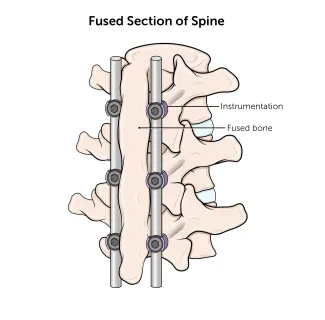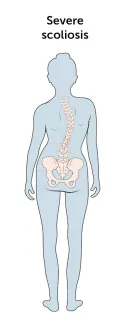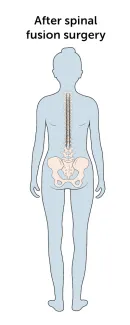Spinal Fusion Surgery | About Spinal Fusion Surgery
How does spinal fusion surgery work?
During spinal fusion surgery, the surgeon stabilizes the curved section of the spine with spinal instrumentation and bone grafts.
- Instrumentation refers to the metal rods, hooks, and screws that surgeons attach to the abnormally curved section of the spine in order to stabilize it in an upright position.
- Bone grafts are small bone chips that the surgeon packs around the abnormal vertebrae. This encourages this section of the spine to heal into a solid bone. This process is similar to the natural healing process of a broken bone. The bone graft may be taken from the patient’s local bone during surgery, or it may come from the hospital’s bone bank.

Recovery from spinal fusion surgery usually takes six to 12 months. Once the bone has fused, the abnormal section of the spine will not curve further. The instrumentation usually remains in the spine without causing problems.
In 2019, Boston Children’s Spine Division became one of the first pediatric hospitals in the world to adopt the Mazor X Stealth Robotic Guidance System. This latest generation of robotic technology assists in the exact placement of surgical hardware minimizing the risk of surgical harm. Learn more about robotic surgical guidance for spinal fusion surgery.
What are the different types of spinal fusion surgery?
Posterior fusion, in which the spine is operated on from behind, is the most common surgery for idiopathic scoliosis and neuromuscular scoliosis. After the patient receives anesthesia and has gone to sleep, they are gently rolled onto their stomach and an incision is made on their back.
- Most patients with idiopathic scoliosis do not need to wear a brace after posterior fusion surgery.
- Most patients with congenital scoliosis or spondylolisthesis have bone grafts but no instrumentation and need to wear a brace while their spine heals after surgery.
Anterior fusion is more commonly used for congenital scoliosis and kyphosis. It is sometimes used in special instances of idiopathic scoliosis and severe neuromuscular scoliosis. After the patient receives anesthesia and has gone to sleep, an incision is made along a rib or down the side of the abdomen so that the surgeon can attach instrumentation to the spine. After a fusion of this type, patients usually have to wear a brace as their spine heals.
Anterior and posterior fusion is necessary in some special cases. Usually the two surgeries can be done on the same day. But sometimes they must be done in separate operations scheduled one or two weeks apart.


What should families expect after spinal fusion surgery?
Different patients recover at different rates from spinal fusion surgery, depending on the type of surgery they had and how much of their spine was involved.
The first few days after surgery
Most patients remain in the hospital for a couple of days after surgery. When they meet certain milestones, like being able to walk, shower, and get dressed on their own, their doctor will discharge them with instructions to continue their recovery at home.
The first few weeks after surgery
Most kids can return to school three to four weeks after spinal fusion surgery. They should not, however, go to gym class or play sports for two to six months, depending on advice from their surgeon.
6 to 12 months after surgery
Within six months to a year, the fused vertebrae will heal into solid, stable bone. This section of the spine will no longer bend or grow beyond its current size. For this reason, most orthopedic surgeons delay spinal fusion surgery, ideally until after a child has reached their mature height. The vertebrae above and below the fused section of spine will continue to move and grow.
Once the patient has been cleared by their doctor, they can return to the activities they enjoyed before surgery. Their doctor may tell them to avoid contact sports like football and rugby.

